IB Biology Year 1 - Molecular Genetics
1/31
There's no tags or description
Looks like no tags are added yet.
Name | Mastery | Learn | Test | Matching | Spaced |
|---|
No study sessions yet.
32 Terms
New DNA strands are manufactured in which of the following directions?
5' -> 3'
Explain 3 differences between RNA and DNA in terms of structure as well as 1 similarity.
RNA is single-stranded while DNA is double-stranded, and RNA has Uracil while DNA has Thymine. Finally, DNA passes hereditary information between generations of cells while RNA codes for making protein during transcription. RNA and DNA are similar in the sense that they are both polymers of nucleotides with a sugar-phosphate bone.
The gene that codes for a particular polypeptide includes the base sequence shown.
GAGTACCCT
What is the base sequence of the DNA strand which is complementary to this sequence?
CTCATGGGA
For what did Hershey and Chase’s work provide evidence for?
DNA as the genetic material of heredity
How did Hershey and Chase’s experiment work?
What is region where the replication fork would be found look like?

Click on an Okazaki fragment.

What is the difference between DNA polymerase III and DNA polymerase I? (include which one has ligase for a sidekick!)
DNA Polymerase III adds free-floating nucleoside triposphate to build the polymer of DNA and it can only build 5' to 3'. DNA Polymerase I, on the other hand, scoops out the primers placed by Primase---especially those multiple found on the lagging (or discontinous) strand, between Okazaki fragments----as those are made of RNA, and eventually those gaps will be filled with DNA by ligase.
The structure would contain multiple points of origin and thus require multiple primers in the process of DNA replication.
Discontinuous strand
Which are necessary to make DNA replication semi-conservative?
I. Separation of the strands by RNA polymerase
II. Complementary base pairing
III. Use of a pre-existing strand as a template
II, III
What is the purpose of single stranded binding proteins?
To prevent the two strands from reattaching.

6
Describe the process of alternative splicing and explain its relationship to the transcriptome and proteome of a cell.
Alternative splicing allows the orginial transcriptome to be presented and ordered in various ways to get different outputs for proteomes. This allows different proteins to be produced with the same genetic code.

Match the enzyme involved in DNA replication with its function.
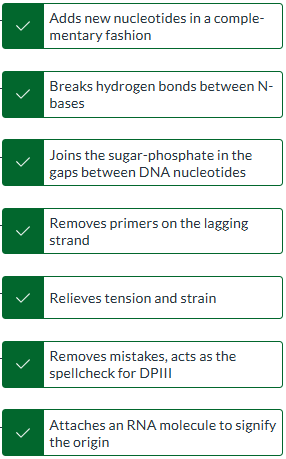
Transcription occurs on the:
Correct answer:
Antisense Strand
Which correctly describes the structure of nucleic acid polymers?
Backbone is covalently bonded sugar-phosphate, and bases are hydrogen bonded.
One strand of DNA runs 3' -> 5', and the other runs 5' -> 3'. Which statement best describes this structure of DNA?
DNA has antiparallel strands

23.7
What technology was necessary for the Hershey and Chase experiment?
Radioactive isotopes

Okazaki fragments
Compare and contrast DNA and RNA.
DNA
Double stranded
Deoxyribose sugar
Thymine
RNA
Ribose sugar
Uracil
Single strand
Both DNA and RNA
Adenine, Cytosine, and Guanine
Made of nucleotides
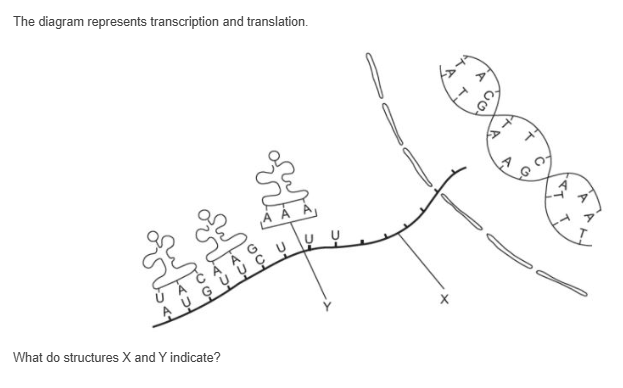
X- mRNA, Y- anticodon
What is a reason that Taq polymerase is a suitable enzyme for use in the polymerase chain reaction (PCR)?
It works at higher temperatures than most enzymes.
Which are examples of non-coding DNA?
Promoters and telomeres
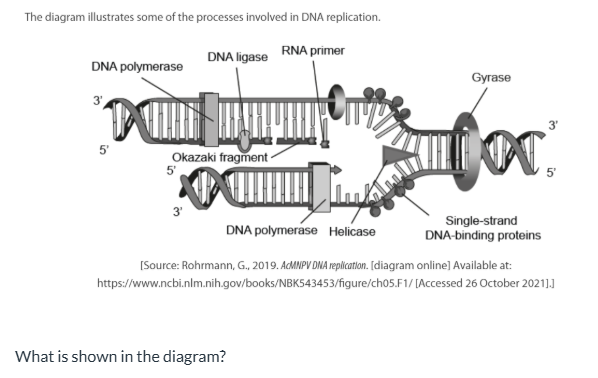
Single-stranded DNA-binding proteins on the old strands
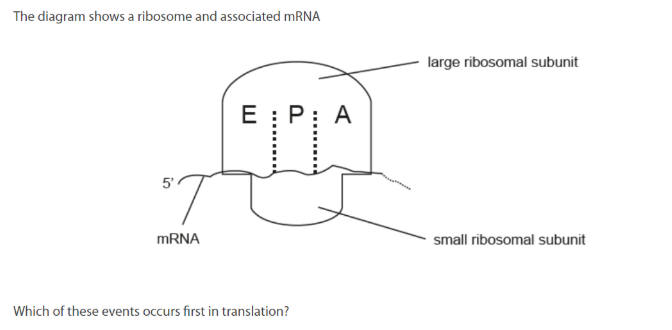
Small ribosomal subunit binds to mRNA.
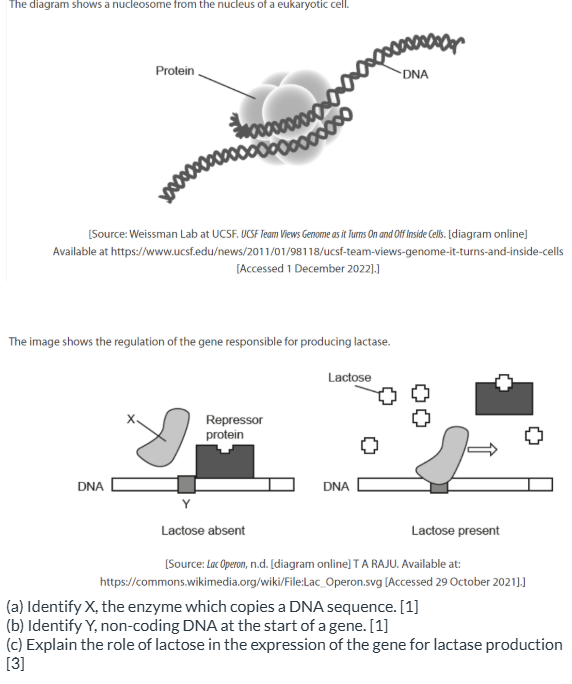
a) Lactase
b) Promoter region
c)
X = RNA Polymerase II
It wants to read the DNA starting from the promoter region (Y)
It cannot b/c repressor protein is in the way
Lactose will occupy the repressor protein and allow RNA Polymerase II to read the DNA
Which statement correctly describes genome and proteome?
In cells of different tissues, the genome is the same while the proteome varies.

54
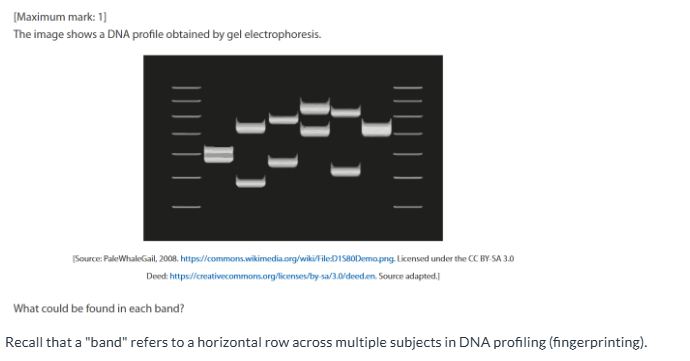
DNA fragments with the same number of base pairs
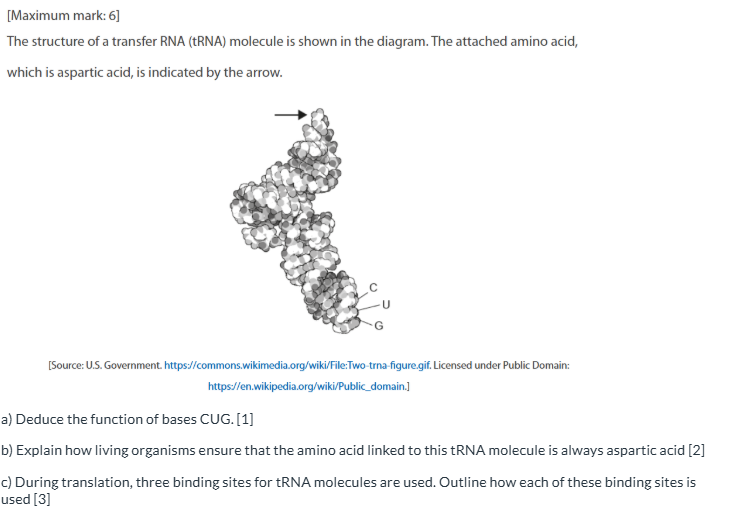
What is the purpose of the poly A-tail and methyl cap? Include when they are formed, what they attach to, where they attach to, and how these structures can regulate protein production.
The the poly A-tail attached to the 3' end of an exon, while the methyl cap attaches to the 5' end of an exon. These are formed right towards the end of transcription, when the splicesomes cut out the exons from the pre-mRNA strands, allowing what is left behind to be degraded (the introns) while preventing the exons from being degraded due to the poly A-tail and the methyl cap. With the poly A-tail, the size of the tail determines the amount of mRNA it can hold, which will allow for a certain amount of proteins to be produced. This is essential to control what is needed for certain circumstances.